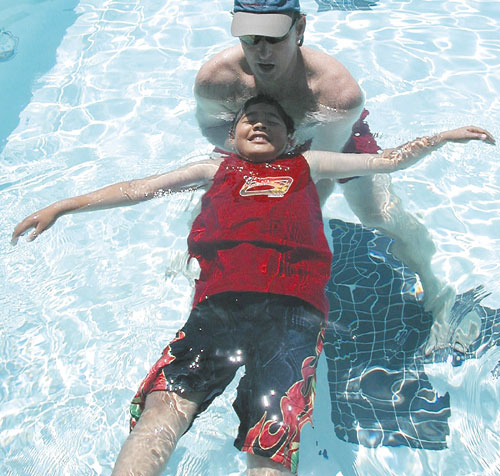It was Memorial Day weekend of 2004 when Dellanira Chang¹s uncle
drowned in the Russian River during a celebration of his birthday
with family members. Playing on a rope swing, the swift current
swept him away.
³We were just messing around, jumping off the ropes and he
jumped off the rope and the current took him,² she recalled. ³We
thought he was joking, but he wasn¹t and he drowned.²
Two years later, Chang is doing something to prevent that
tragedy from being repeated among other Latino families as part of
the ³Vamos a Nadar² (Let¹s Go Swimming) program sponsored by the
Sonoma County Chapter of the American Red Cross.
Now in its third year, the free one-day water safety class
includes swimming lessons for children and water safety lessons and
lifesaving demonstrations for parents. In conjunction with the
program, the Red Cross is also offering ³Vamos a ser Salvavidas²
(Let¹s Save Lives), a bilingual lifeguard training program. That¹s
initially how Chang got involved.
The 16-year-old Latina could barely swim when she met Rosiris
Guerra on the Elsie Allen High School campus last year, where
Guerras was recruiting bilingual lifeguard candidates. ³I was a
really bad swimmer,² Chang admits, but remembering her uncle¹s
death, ³kind of determined me to take the lifeguarding class.²
With the encouragement of the Red Cross and the staff at the
Finley Aquatic Center in Santa Rosa, she got into shape, spent
weeks learning to be a better swimmer and passed the lifeguard
test. She said her instructor, Don Hicks, ³was really patient with
me. At first he was like, Œthis girl is not going to make it.¹ But
I had a lot of determination … I had a goal.²
She passed the class and now she is working as a lifeguard and
helps present the Vamos a Nadar program in Spanish.
The Red Cross program is part of a larger effort to reduce
drownings in the Russian River, with particular attention on the
Latino community. According to the Red Cross, the Hispanic
community comprises 20 percent of the county¹s population, but
accounts for 75 percent of the drowning deaths.
Guerra is part of a countywide Water Safety Committee formed to
prevent drownings and counter a sharp increase in deaths among
Latinos. ³It came into my head, ŒWe need a long-term solution,¹²
she said, and that¹s where she came up with the idea for swim
lessons and safety lectures.
The first year there were 56 children and their families
involved, the second year there were 140 kids. This year, the goal
is to reach 180 children and their parents.
³This is important because we want to prevent any more drownings
in the community,² said Guerra. ³In the pools, lakes, river …
anywhere. Our goal is that there are zero drownings. We want to
make sure people don¹t keep dying in the Russian River and in the
pools because they don¹t know how to swim or don¹t know about water
safety.²
The first lessons took place recently in Santa Rosa, and three
other sessions are planned: June 17 at the Petaluma Swim Center;
June 24 at Sebastopol¹s Ives Pool; and July 1 at the Cloverdale
Pool. To register, call the Red Cross at 577-7611.
Chang agreed that the water safety is particularly important for
Mexican-Americans. ³Because in the Mexican culture, we go to the
River and it¹s a family tradition and we are not taught the right
things about water safety,² she said. ³They teach us things they
shouldn¹t that are superstitious … like they tell us to go in the
water with shoes … a lot of the stuff they tell us is wrong, when
they can¹t even swim themselves.²
Parents also hear first-hand about what it¹s like to lose a
child to drowning. Michelle Wilder, whose son, Robert, drowned last
year in the Russian River and who formed the ³Pebble in the Pond²
project, spoke to parents during the Vamos a Nadar program in Santa
Rosa.
³She told them, Œmake sure your kids know how to swim,¹² said
Guerra. ³It was very powerful … they were asking a lot of
questions. She is doing the next three sessions that we have.²
After the initial swim lesson, parents and children get a
demonstration on what to do if someone is in trouble without
getting in the water. The kids then go back in the water for
another lesson and parents get a chance to ask questions. ³If we
empower them with the information, then hopefully things will
change,² said Guerra.
Chang said it¹s especially important ³just to get the word out
there. On Memorial Day, everybody goes in the water, but we don¹t
know what to do to keep safe. We need to. Take a swimming class if
you don¹t know how to swim. Keep yourself safe before you help
anybody else.²
51.1
F
Healdsburg
April 14, 2025








